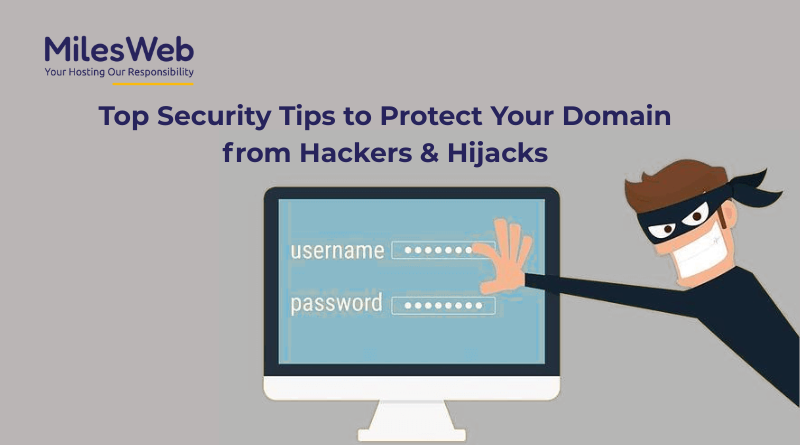
Your domain is the face of your brand on the internet and not just a web address. But in 2025, more than 32,000 domains are hijacked or targeted each month, frequently without the owners even knowing it until it’s too late. While companies rush to get the cheapest domain name or grab a free domain name with a hosting deal, they tend to neglect the most important part of the equation: domain security.
What will happen if your domain is hijacked? Everything will be at risk. Similarly, not securing your domain is like leaving your storefront wide open for the hijackers, phishers, and cyberattackers to steal your visitors or even resell your domain on the black market.
Thankfully, domain registration services such as MilesWeb not only provide feature-packed protection at affordable prices but also have tools to monitor and protect your domain. Whether you’re beginning with a free domain name or searching for the lowest-cost domain name to kick-start your idea, intelligent protection begins here.
In this blog, we will look at effective and actionable tips on how to protect your domain from hijackers and hackers so that you can develop a successful brand.
Domain Hijacking Defined
Domain hijacking is a term that explains that your domain has been stolen. In other words, it means someone has penetrated your domain registrar account credentials and has full authority over your domain functions, domain transfer, and changing its name servers, as well as its new status.
It could completely destroy your business. Your entire business can be put at risk if you do not get back the domain ownership. If your domain name is hijacked, then an attacker is likely to transfer it to some other registrar, and this is the most common thing regarding these cases. Once it is done, taking it back to the original owner becomes even more complicated.
9 Steps to Prevent Domain Hijacking
1. Select a Trusted Domain Registrar Company
There are numerous kinds of domain registrars in the market, and they all provide the same service, i.e., they enable you to register a domain name. Their prices may differ, but that should not be your sole concern. When selecting your domain name registrar for new domain registrations or transferring existing domains, look at the advanced and additional features they provide. For instance, two-factor authentication, DNS management, customer support, and protection of copyright and trademark to prevent domain squatting and hijacking.
2. Enable Two-Factor Authentication
Enable the Two Factor Authentication feature on all your online accounts, including your domain name register. The additional layer of security offered by the 2FA can help you keep from losing control of your domains if someone gets your username and password.
3. Always Enable Domain Locking
Domain locks are indeed the most common domain security tool offered by every registrar. It will bar an unauthorized transfer of your domain name to another registrar.
4. Enable WHOIS Protection
Turning on the WHOIS protection helps considerably reduce the amount of personal data that you reveal on the Internet. Your domain WHOIS information contains very personal information that can be used for launching social engineering attacks against you. When you enable WHOIS protection, it will greatly minimize the amount of vulnerable OSINT data about you or your company that could be used against you.
5. Always Use a Strong Password
The use of powerful passwords can avoid brute force attacks and malicious access to your account. Passwords should be restricted to a minimum of eight characters. Don’t use any dictionary words as a password, and it should contain a combination of letters in both uppercase and lowercase, numbers, and symbols.
6. Periodically Change Your Password
According to the advice of many security experts, passwords should be changed after every 72 to 90 days. Always keep in mind: every time you change a password, use a strong password.
7. Regularly Update Your Domain Contact Details
Ensure that your domain contact information is always kept accurate and up to date at all times. In an emergency, your contact details, administrative, technical, and abuse details must always indicate accurate contact details. This way, your domain registrar can alert you if they notice there is any possible security compromise with your account.
8. Limit Access to Your Domain Account
Never share your domain account details with any individual whom you cannot trust completely. The truth is that you can easily do the DNS configurations for your domain names, change the DNS records, or even add a new name server; it is not rocket science. But if you have no idea how to do it yourself, just take the help of your domain registrar, but never give your login details to strangers.
9. Beware of phishing emails
Phishing attacks keep happening every day. If you get a suspicious email from your registrar asking you to click on a link or asking you for your client area username or passwords, do not do it. First of all, contact your domain registrar from the official web page; never click on any link inside the suspicious email; and forward the email you received to their technical support so they can determine whether it is real or if it is indeed a phishing attack.
You can also receive phishing emails that seem to be coming from ICANN. In that case, you should forward your email to [email protected] to verify its authenticity.
Conclusion
Securing your domain is not a technical challenge, but it’s a strategic decision to protect your brand’s reputation and future. By adhering to the aforementioned security protocols, you can ensure your digital belongings are safe from cyberattackers. And when selecting a safe domain registrar, MilesWeb emerges as a preferred choice due to its trustworthy services, WHOIS privacy protection, copyright and trademark protection, and 24/7 support. Don’t just register your domain; secure it intelligently from today onwards.
Also Read: VPS Hosting vs. Dedicated Server Hosting: A Detailed Comparison
